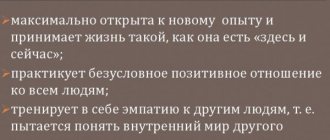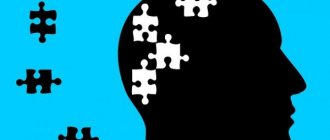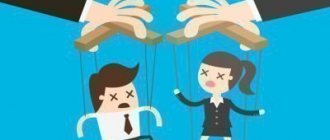Self-regulation is the body’s ability to maintain a balance of psycho-emotional state. Each of us has problems and difficulties that lead to depression and apathy and cause a storm of negative emotions. It happens that we worry about something, worry, worsening our mood even more. And at some point you give up, and the desire to act completely disappears. How can self-regulation help in such cases? How can you use it to restore inner harmony and calm down?
What is self-regulation
Mental self-regulation in psychology is the ability of an individual to analyze, evaluate, and then adjust both his own activity and its results. Essentially, this word means to put things in order. In this context, we can say that self-regulation of a person is a person’s conscious and organized influence on his own psyche, the main purpose of which is to change its properties and characteristics in the right direction.
Self-regulation of the body is based on patterns and their consequences, called psychological effects:
- motivating factors that encourage a person to act actively, while directing his efforts to change personal characteristics;
- the result of controlling voluntary or involuntary images arising in the subconscious;
- integrity and unity of cognitive processes that ensure the individual’s ability to influence his own psyche;
- the integrity of parts of consciousness and areas of the unconscious, with the help of which a person carries out self-regulation;
- functional connection between the emotional-volitional part of the personality and bodily experience, thinking.
Psychological self-regulation begins when an individual has a contradiction related to motivation. It can be safely called a driving force that encourages you to reconsider your inner world and some character traits.
Features of RPS methods
Mental self-regulation is ways to manage your own physical, mental and emotional state by performing light exercises, thinking skills or deep visualization. After mastering the technique, you can improve your psycho-emotional state, learn to manage behavior, improve productivity and understand how to make decisions correctly.
Self-regulation in psychology is a diverse phenomenon, the most common approaches to its development are:
- neuromuscular relaxation;
- autogenic and ideomotor training;
- sensory reproduction of images.
The objectives of these methods are:
- reduction of stress or emotional tension;
- reducing the possibility of undesirable consequences;
- mobilization of resources to achieve the plan.
Neuromuscular relaxation
Neuromuscular relaxation is a set of gentle physical exercises designed to reduce nervous tension and relax the muscles of the body.
The main idea of this approach is to calm the psyche through active muscle relaxation. With proper execution and alternation of the necessary exercises, you can achieve maximum relaxation of the body and reduce the manifestation of neurotic conditions and get rid of insomnia.
Autogenic training
Autogenic training (autotraining) is one of the most universal methods of relaxation that you can master on your own. It is a set of mental exercises to relax the body and mind. The essence of the approach is to relieve tension through absolute relaxation, reduce stress and the feeling of fatigue.
Autotraining is in many ways similar to self-hypnosis, since it uses the same techniques to immerse oneself in a deep, calm state, reminiscent of the borderline state between sleep and wakefulness. The classic method of auto-training consists of 2 steps: physical relaxation using mental scanning of the whole body, and deep visualization of relaxation.
Ideomotor training
Ideomotor training is an effective way to improve your own cognitive or professional skills. The essence of the approach is to mentally experience the situation, reproducing the sensations associated with future activity (the sensations of performing, playing sports or playing the piano).
In order for ideomotor training to be as effective as possible, it is necessary to imagine the maximum number of details and your own feelings, to see yourself as an actor.
This training promotes self-programming, increases confidence in one's own competence and gives a sense of control over the situation.
It is necessary to train at 2 levels:
- external (active visualization of the situation);
- internal (imagine visual, auditory and tactile sensations from one’s own experiences at one or another moment of visualization).
Sensory reproduction of images
Sensory imagery is a relaxation method with active visualization of a positive situation that reflects the achievement of the desired (for example, imagining a walk in the forest or a successful public speech).
For this method to bear fruit, you must use deep visualization:
- draw a detailed image of an imaginary situation;
- breathe deeply and slowly;
- try to evoke positive emotions and pleasant sensations from the mental image.
This relaxation technique aims to calm the nervous system and regulate blood pressure.
Self-regulation functions
The main task of self-regulation is to change mental activity so that a person can achieve internal harmony and balance. What does this give?
- The ability to restrain yourself from “exploding” in a conflict situation. A quarrel can be prevented before it even begins.
- In times of crisis or severe stress, a person can think adequately and make the right decisions.
- The individual can regain emotional strength.
And finally, the last function is confrontation with problems. Self-regulation allows you to achieve harmony with yourself and in relationships with others, which significantly improves your quality of life and helps you cope with any difficulties.
When is self-regulation needed?
A person experiences the need for self-regulation of mental states in several cases:
- with frequent irritability;
- with imbalance;
- if there is a feeling of emotional overstrain, bad mood;
- with depression, apathy, lack of joy and satisfaction from life;
- with decreased performance and endurance.
There are other factors whose presence prompts you to think about self-regulation. We are talking about a lack of self-confidence, low self-esteem, the inability or even inability to influence what is happening around, a lack of willpower and courage. Here you can add dissatisfaction from interaction with others, for example, failures in your personal life.
It is worth noting the fact that stressful situations are characterized by disturbances not only in the mental state, but also in physical health. Thus, a person’s general health deteriorates, causeless pain and sleep problems appear (most often insomnia). This also includes problems with excess weight. Remember how often in stressful situations we “eat up” negative emotions with something tasty, for example, another piece of cake or candy.
Kinds
There are the following types of human self-regulation:
- arbitrary;
- involuntary.
In the first case, a person clearly sees the goal and consciously controls his behavior to achieve it. This is how he develops individuality. In the second, the task of self-regulation is to survive and maintain health. It turns out that subconscious protection is triggered here.
In adulthood and old age, self-regulation is designed to maintain the connection between mind and emotions. But as the body ages, the balance shifts towards the latter.
An individual’s self-regulation is influenced by the conditions of the environment in which he lives, the characteristics of his inner “I” and communication with others, as well as the purpose of his actions.
From all of the above, we can conclude that self-regulation is methods and techniques for controlling feelings and emotions, as well as correct reactions to the norms of behavior and interaction with other people established in society.
Theories of self-regulation
In psychology, two theories of self-regulation are known.
System-activity
The author of this theory is L. G. Dikaya. According to her, self-regulation is an activity aimed at adaptation in a professional environment. It is also considered as a system for a person’s transition from unconscious forms of activity to conscious, almost automatic ones.
L. G. Dikaya conventionally identified several levels of mental self-regulation:
- Involuntary. It is based on excitation and inhibition, as well as activity uncharacteristic of the psyche. Such reactions fade away quickly and cannot be controlled.
- Arbitrary. Self-regulation is activated in critical situations. Here the intellect is united with emotions. All this manifests itself in increased motor activity, holding your breath, and a feeling of tension in the muscles.
- Conscious. A person not only realizes the presence of discomfort, but is also able to assess the severity of the condition. As a result, he decides to radically change the situation, using self-control, willpower, psychophysical exercises and auto-training.
The last and most interesting level is purposeful awareness. The individual understands that he can no longer tolerate what is happening in his life. Trying to get rid of unbearable discomfort, he reconsiders his values and priorities, and also analyzes his motives, desires and needs. There are two options for the development of events. In the first case, a person refuses activities that bring inconvenience and takes on his condition. In the second, the individual continues his activity, but at the same time includes self-regulation. Techniques such as self-hypnosis, introspection, and self-persuasion are used here.
In both cases, changes affect both behavior and the personality itself.
System-functional
The author of this theory of self-regulation is A. O. Prokhorov. In his opinion, self-regulation is nothing more than a change from one mental state to another. Moreover, the latter is connected with a person’s idea of the mood that he should have.
In order to obtain the desired reaction to conflict situations, an individual goes through several intermediate states. As a result, the reaction becomes conscious.
Prokhorov believed that the success of self-regulation directly depends on the level of awareness. It is also influenced by the accuracy of the presented image, the realism of feelings and emotions. The correctness of the achieved state is assessed based on bodily sensations, breathing, time, etc.
What is stress and why is it dangerous?
Stress is an invisible weapon that leads to the destruction of body cells and ultimately manifests itself through various diseases. After a stressful situation occurs, impulses are formed in the human brain that are sent to the cardiovascular, immune and endocrine systems. This is quite enough not only to disrupt self-control and lose vigilance, but also to cause a number of complex diseases. When stress becomes chronic, its effects can be devastating.
The famous neuroendocrinologist McEwen, winner of many prizes and awards, proved:
- prolonged stress has a very bad effect on human memory, which leads to atrophy of neurons,
— acute and prolonged stress suppresses the body’s immune functions, making it weak and defenseless to resistance,
— in the process of stress, the human body produces glucocorticoids, which in the short term have a beneficial effect on it. But as a result of prolonged stress and increased levels of glucocorticoids in the body, it prevents insulin from working in the body, which helps in the absorption of glucose.
It is important to note that stress interferes with:
- control your own fear,
- reduces reproductive functions in the stronger sex,
- damages teeth and gums,
- leads to imbalance throughout the body.
Components and levels of self-regulation
Self-regulation of emotional states is based on two mechanisms:
- Self-control. It first appears at about two years of age. It involves giving up something pleasant in order to achieve your goals.
- Agreement. Every person agrees that there is right and wrong behavior. At the age of 7, children can agree and refuse consciously.
A person who wants to master conscious self-regulation needs qualities such as: responsibility, flexibility, independence, perseverance, etc. You will also need will, the ability to find new motives and incentives to action. Based on this, the following levels of self-regulation can be distinguished:
- Operational and technical. This is a conscious activity that uses available means and resources.
- Motivational. This is a conscious direction of activity in the right direction by managing emotions and needs.
Self-regulation is not an automatic psychological defense mechanism. This is a conscious life choice. It is activated in situations where there is a need to change oneself, and not circumstances.
Approaches in psychology
In domestic psychology, the definition of emotional regulation is found in the following contexts:
- self-regulation of personality;
- regulation of behavior;
- mental self-regulation;
- self-regulation of states.
The mechanism of self-regulation and regulation of emotional states was considered by F.B. Berezin. In his works, the regulation of the body is associated with mental adaptation. Berezin argues that psychological defenses counter anxiety and stress. The research conducted led Berezin to the conclusion that there are individual personality characteristics that help to successfully adapt to stress. This is the level of neuropsychic stability, self-esteem, emotional response in conflicts and others.
The well-known approach of R.M. Granovskaya. She divides all methods of emotional regulation into three groups:
- Eliminating the problem.
- Reduce the intensity of a problem by changing your perspective.
- Relieve the impact of a negative situation using a number of methods.
Regulate the condition of R.M. Granovskaya suggests using weakening motivation. For example, you can reduce emotional tension when achieving a goal by concentrating not on the final result, but on tactics.
Features of self-regulation by gender
The emotional state of women is more fragile than that of men. Therefore, they see and perceive most situations differently. Self-regulation in their case does not have the same direction. If for men it is internal, then for the fair sex it is external.
The remaining differences are summarized in the table:
| Men | Women |
| Less likely to experience fear, anxiety, irritation and other negative emotions | Psycho-emotional state is less stable than in men |
| More often left alone, experience depression and apathy | Loneliness often causes depression |
| Self-regulation has a biological basis, which means there are more ways to express it | Self-regulation most often has a social nature |
Differences in male and female self-regulation are due to several factors:
- gender stereotypes;
- differences in the upbringing of boys and girls;
- type of professional activity;
- social roles.
You can also add to the list the level of personality development of a particular person, mental state, and age characteristics.
The formation of self-regulation
As mentioned above, a person learns the basics of self-regulation in childhood. The process of its formation looks like this:
- From 3 to 4 years. In most cases, changes in the functional state occur involuntarily. Involuntary speech and motor methods of self-regulation alternate with voluntary or conscious ones in a ratio of 7-8 to 1.
- From 4 to 5 years. Children learn to manage their emotions through play. At this age the ratio looks like 4 to 1.
- From 5 to 6 years. The ratio of involuntary and voluntary self-regulation returns to normal (1 to 1). At this level, children have access to imagination, memory, thinking, and speech.
- 6-7 years. At this age, the child has access to such methods of self-regulation as self-control and self-correction. The ratio changes in the opposite direction. For every 1 involuntary method of psychological self-regulation there are 3-4 voluntary, conscious ones.
- The interval is 8-20 years. During this period, the teenager, and then the young man, improves the methods of self-regulation he uses, and also adopts something from those around him.
- Age from 20 to 40 years. The methods of changing the emotional state directly depend on what activity the individual is engaged in. Most often we are talking about the use of conscious methods.
- 40-60 years old. Attention manipulations are still effective. However, more and more often people are replacing them with something passive, for example, a quiet rest, a walk in nature or a trip to the library.
After 60 years, self-regulation is carried out only by passive methods. In most cases, this is communication, thinking alone, etc.
Self-regulation techniques
First of all, it is worth saying that there are natural ways of self-regulation. These include:
- listening to classical music;
- walks in the fresh air, for example, in a nearby park;
- adequate rest and sleep;
- smiles, humor;
- reading your favorite books;
- drawing, embroidery;
- thinking about something good;
- singing, dancing;
- observing the beautiful landscape;
- pleasant memories, viewing photographs;
- sunbathing;
- communication with people who evoke exclusively positive emotions.
There are other methods and techniques of self-regulation:
- Relaxation. Everyone chooses their own way of relaxation. The main thing is that he achieves his goal: to achieve inner harmony, relieve muscle tension, regain control over feelings and emotions.
- Meditation. Helps you learn to concentrate, relax, relieve psycho-emotional stress and distract yourself from bad thoughts. Breathing techniques are most often used during meditation. The easiest option is to think about anything, just not about what annoys you.
- Desensitization. Involves conscious passivity, a clear idea of what successful behavior or activity looks like, and neutrality in relation to stimuli. All this is achieved through self-hypnosis.
- Autogenic training. Based on relaxation methods. They are exercises for relaxing muscles, developing the ability to accurately monitor the state of the body, and increasing volitional attitudes. The main task of this method of self-regulation is to relieve any tension and achieve absolute relaxation of the mind and body.
Don’t forget about visualization - creating a mental image of what you want, your goal. You need to imagine the end result and how you will go towards it.
TECHNIQUES FOR MENTAL SELF-REGULATION OF EMOTIONAL STATES
Ageenkova E.K. A set of techniques for mental self-regulation of emotional states for the prevention and rehabilitation of somatic disorders, crisis conditions and fatigue in military personnel. //Military Psychological Bulletin. Information and methodological manual for officers of the socio-psychological structure of the Armed Forces of the Republic of Belarus. /Ed. A.N. Gura. – Minsk: Center for Ideological Work of the State Committee for Educational Institution “Central Educational Directorate of the Armed Forces of the Republic of Belarus”, 2008. - No. 1. – P. 13 – 59.
Section 4 TECHNIQUES OF MENTAL SELF-REGULATION
EMOTIONAL STATES
Methods of mental self-regulation have their advantages over other methods of psychological correction for the following reasons.
Firstly, the use of methods of manipulative psychotherapeutic technologies, most often used at present, can increase a person’s dependence on psychotherapists and reduce his adaptive capabilities. Knowledge of the basic techniques of mental self-regulation allows each person to independently cope with emerging problems and, thus, more fully self-actualize.
Secondly, the body itself is an autonomous self-regulating system capable of maintaining its functioning. Methods of mental self-regulation make it possible to eliminate factors that disrupt its homeostatic balance and lead to self-destruction.
Thirdly, the conditions of modern life and especially the living conditions of a military personnel require great physical and mental stress, often leading to stagnation that is not eliminated during periods of natural rest. The high pace of life does not always allow you to use the time-extended services of classical psychotherapists. The use of mental self-regulation techniques allows you to quickly eliminate negative mental states that are prone to delay on your own.
When teaching Techniques of mental self-regulation, it is necessary to take into account some important points.
- Mental self-regulation is not a sport. Therefore, when teaching its techniques, excessive zeal and excitement are absolutely contraindicated.
- When independently learning the techniques of mental self-regulation, it is important to take into account the basic rules for optimizing this process and safety recommendations. They are given at the beginning of the section “Static relaxation methods”.
- These techniques are learned most effectively when you are in a balanced mental state. If you are in a state of personal crisis or mental disorder, then you need to study them under the supervision of a medical psychologist or psychotherapist. It is also necessary to know that for some disorders the use of these methods will be ineffective; for a number of other disorders they can be used only with concomitant psychotherapeutic and drug treatment and only under the supervision of a doctor.
What is mental self-regulation
The proposed set of psychotechniques is based on the concepts accepted in biology about the self-regulation of biological systems, including the human body. Self-regulation is the property of biological systems to automatically establish and maintain their physiological parameters at a certain relatively constant level. In a biological system, control factors are not located outside the body, but are formed within it. The body has an adaptive or self-adjusting system of self-regulation. Adaptation is a set of characteristics of an organism that ensures the possibility of its existence in changing environmental conditions.
When “retuning” the body when adapting to new conditions, it experiences tension, which G. Selye called stress. At the same time, he pointed out that stress can have both a positive and negative effect on the body. With a very high intensity of stress, arising from both emotiogenic and physical factors, as well as with stress of low intensity, but lasting for a long period, it turns into distress and becomes pathogenic and can cause somatic disorders. From the perspective of the theory of homeostasis, this is considered as the inability of self-regulatory mechanisms to return to the original stationary state or form another stationary state.
The personal structure of a person, just like the body, is a systemic formation and has homeostasis, by the mechanism of which it either maintains its constancy against the background of changing external conditions, or moves from its primary stationary state to another using the mechanism of self-regulation.
Behavioral and mental reactions to it are important for the nature of the consequences (positive or negative) of stress on the body. This value is especially important when shaping a person’s response to emotional stress. In this regard, every person has the opportunity, through their behavior, to either avoid it or change their reaction to the stressors that cause it. The inability to properly organize your mental life and manage your emotional states often leads to somatic illnesses or mental disorders.
For example, observations of sick people show that in most cases, at the time of a hypertensive crisis or myocardial infarction, contrary to generally accepted opinion, they did not show any painful symptoms; the disease most often began against the background of complete external well-being. However, it turns out that they experienced mental stress earlier, for some a week ago, for others a month, and for others years have passed since then. But this person, it turns out, was thinking about them all the time, mentally recreating these events again and again and experiencing them again.
The human body is designed in such a way that it reacts in the same way both to real life circumstances and to their mental representation. With these imaginary experiences, blood pressure, breathing and heart rhythms change, and metabolic processes are rearranged. Thus, a person, with his disorganized consciousness, maintains the body in a state of constant tension, which corresponds to the emergence of distress through the mechanism of stress of low intensity, but lasting for a long period, which after some time can lead to a breakdown of some functional system.
Normally, after the cessation of stress factors, the functioning of the body returns to its original state of homeostatic equilibrium within 15 to 30 minutes. However, it is known that in the case of psycho-emotional stress and especially when reacting with negative emotions to crisis life circumstances, we cannot always recover in these 15 - 30 minutes, because We mentally relive this situation again and again. In such cases, there is a prolongation or stretching of the stress state over time and overstrain of all physiological systems. In this state, the body's self-regulatory mechanisms cannot bring it to a state of initial homeostatic equilibrium. It should also be noted that images, initially arbitrarily returned by the individual to the field of his internal picture of the world, according to the learning mechanism, can become painfully intrusive and, without his desire, be present in his own consciousness.
By improperly organizing his mental life, a person can lead his body to a psychosomatic illness. Constant delving into the world of one’s own experiences, mental replaying of situations that have already happened, or those that can happen, but which currently do not exist and will never happen, impoverish a person’s life and force them to live in constant tension. Negative ideas, according to our observations, have three varieties: 1) an unpleasant real situation is remembered; 2) a dispute or showdown with an imaginary enemy; 3) suspicious people often imagine future negative events.
Thus, we can conclude about the role of the psychological factor in maintaining a stressful state and turning it into distress. It is expressed in maintaining the autonomic systems of the body in constant tension through mental representations of negative events, which can lead it to functional painful restructuring. In addition, the rigidity of the emotional state, according to body-oriented theories of psychology, causes rigidity of certain muscle groups, especially pronounced hypertonicity of the trapezius and occipital muscles, onto which, as a rule, negative emotions are projected. In persons with a long “experience” of a monotonous emotional response, their hypertrophy is observed, which even over time leads to a change in the bodily constitution.
The identified patterns made it possible to select and improve methods of mental self-regulation both for the prevention of problems of personal development and somatic diseases, and for their non-directive psychotherapy.
Methods of mental self-regulation are based on the process of their natural restoration, i.e. homeostasis mechanism. In fact, self-regulation methods only help to eliminate those mental and physical obstacles that interfere with the normal functioning of the body.
Experience with various methods has shown that the most convenient way to identify in the field of perception those specific objects to which mental self-regulation will be directed is the approach of F. Perls, who identified three zones of awareness in the internal picture of the human world: external, internal and middle.
| 1 |
| 2 |
| 3 |
In the external zone of awareness (1) images of the external world are presented. They are formed according to the mechanisms of sensation and perception through five analyzers: visual, auditory, tactile, olfactory and gustatory.
Through the internal zone of awareness (2), a person feels his body and its individual parts. The mechanism of these sensations is also objective and is provided by ascending nerve pathways coming from interoreceptors. In the external and internal zones of awareness there is, although informationally transformed, but still an objective reality with which the individual is dealing at a given moment in time, i.e. "here and now."
In the middle zone of awareness (3), unlike those described earlier, there are images, sensations of experiences that are created not by reflecting objective reality, but by synthesizing images of the internal picture of the world from elements extracted from memory. These synthesized images are created by fantasizing, daydreaming, thinking, memories according to the mechanism of thinking, representation and imagination, i.e. in the middle zone of awareness the world that exists “there and then” is reflected.
The ability to apply methods of mental self-regulation is associated with the identification and accurate perception of those objects in the internal mental space of a person to which their corrective action will be directed.
At the next stage, the task is to identify images, fantasies, ideas from the middle zone of awareness that are associated with anxiety and mental stress and learn to correct them. This approach is called the thought control method.
Subsequently, the perception of the internal zone of awareness and the skill of voluntary correction of those physiological states of the body through which emotions manifest themselves are practiced. This method of self-regulation is called the method of controlling body functions.
Among the methods of mental self-regulation based on knowledge of psychotechniques, the following are considered:
< >methods of thinking control (correction of states of the middle zone of awareness); methods of control of body functions (correction of the internal zone of awareness);
methods of regulation through a trance state (combining techniques of work in the internal and middle zones of awareness). Psychotechniques for self-regulation of emotional states
| Self-regulation through thought control | Self-regulation through control of body functions | Self-regulation through a trance state |
Methods for controlling breathing Methods for controlling muscle tone
Static methods Dynamic methods
Gymnastic techniques Techniques for developing posture and coordination of movements
Methods of thinking control are basic for all other self-regulatory techniques. They consist either in controlling the quality of the picture of events that the individual considers in the imagination, or in stopping mental representations.
The formation of methods for controlling body functions is based on the fact that emotional states necessarily manifest themselves in changes in the functioning of physiological systems. Therefore, many historically established systems of mental self-regulation are based on the regulation of two functions of the body - breathing and muscle tone, which each person is able to voluntarily control.
The basis for using methods of breathing regulation is a change in the psycho-emotional state depending on its depth and the ratio of the duration of inhalation and exhalation.
In the techniques of static muscle relaxation, we have identified some contraindications or limitations to the use of certain approaches adopted in autotraining based on the I. Schultz method. Many researchers have pointed out the occurrence of various kinds of psychological and physiological problems when using it. The main contraindications, at least for certain groups of people, are: a) “coachman’s pose”, b) the use of a “feeling of heaviness” to stimulate relaxation, c) concentration on the activity of internal organs. From our point of view, it is unnecessary to take autosuggestion against the background of a half-asleep state with verbal accompaniment of relaxation. On the other hand, in contrast to the “sanatorium-resort” versions of auto-training, the emphasis was placed on maintaining clarity of consciousness and control of reality, as is common in classical meditation techniques. All these aspects required the compilation of a large list of “safety rules” for relaxation.
Since carrying out static muscle relaxation is difficult for many, this manual offers its dynamic options: gymnastics to stretch various muscle groups and joint ligaments, as well as the ability to relax the body while moving. These techniques have been sufficiently developed, indicating their indications and contraindications in physical therapy, sports, yoga, qigong, Russian healing techniques, in the methods of Reich, Lowen, Feldenkrais, Alexander and others.
Methods of regulation through a trance state are the most difficult to present in popular publications. They are designed for self-modeling of deep mental processes, which is carried out through special or altered states of consciousness.
The presented methods relate to psychotechnical techniques, which are based on volitional effort aimed at eliminating factors that lead the human psyche and body to tension, and towards bringing them to homeostatic balance. In addition to special psychotechnical ones, natural methods of self-regulation can work in this direction (choosing or creating an external environment that helps return the body to homeostatic balance); methods based on the use of stress states (in a state of stress, through the mechanism of aversive learning, the necessary skill is quickly acquired); methods based on education and self-education (with proper development of personality, emotional reactions to stressful influences are regulated by its value orientations and in this case psychotechnics may not be needed).
Techniques of mental self-regulation
Thought control methods
These methods are intended to directly regulate the states of our consciousness. They can shape the culture of our mental life and consciousness.
Most adults have forgotten how to live in the real world and exist in their imaginations. It’s as if we are constantly watching a certain video film created from elements of our memories and fantasies, we live in it, and immediate reality is perceived in blurred forms. Figuratively speaking, our mental space is a translucent shell, through the walls of which our consciousness controls only certain aspects of external reality. But to a greater extent, it is fascinated by the contemplation of its own internal mental content.
Japanese writer Kobo Abe has a story called “The Box Man.” The main character walks around the city, wearing a cardboard box with small windows in it. The inside of the box is a kind of room in which there are some “interior” items. Being inside the box, a person is able to be in the external space and even navigate in it, but, on the other hand, he is at the same time isolated from it, because constantly interacts with the inside of his box, with the objects that he himself placed there.
Unfortunately, such a mental existence “in a box” is inherent in any person. The interior of this box can be painted with dark colors of melancholy, envy, irritation, and anger. This is a metaphor, but you must admit that each of us is such a “box person”. If we are, then naturally we need to learn to navigate and control our own mental spaces.
To develop the skill of controlling the states of the middle zone of awareness, our method includes a set of training practical exercises.
The simplest option for controlling thinking is to monitor the quality of the picture of events that we are currently considering in front of our inner gaze when we are in the middle zone of awareness. Make sure that: a) these psychological images are not emotionally colored by negative experiences: anger, doubt, irritation, fear, argument or showdown with your opponents; b) so that you restrain your desire to return this negatively colored emotional image to your consciousness, otherwise you will be forced to remain in it constantly after some time. At the same time, the thought “gets stuck” and repeats itself monotonously over and over again, like on a broken record. Vladimir Monomakh spoke beautifully about this: you cannot “think nonsense.”
These conditions are unfavorable for both your psyche and your body. Try to immediately switch your attention either to reality, or, as a last resort, to pleasant memories, to drawing up personal plans, and even better to the creative process; this is, in fact, what our mind is designed for.
We must remember that it is necessary to get rid of negative ideas immediately. After we have already replayed an unpleasant situation in our thoughts several times, such a state can become entrenched in our consciousness and it may be impossible to get rid of it; this thought becomes our mistress.
We all tend to live in our ideas, thoughts, feelings, rather than in reality. Moreover, we often get “stuck” in the mental replay of negative events, and this disturbing picture of ideas begins to destroy our soul and body.
The ability to control one’s mental state, according to most Slavic thinkers, is the basis of human spiritual culture. The most important in this regard, in my opinion, are the works of Nil Sorsky, one of the most interesting people in our history. I believe that his work “Nile of Sorsky Tradition and Rule” has not lost its significance at the present time and is key in mental self-regulation. He considered the most important thing in the spiritual development of a person to be “observation of the mind,” without which bodily and other external forms of “spiritual activity” are “false and fruitless.” He wrote that the most holy thoughts come into the head of the most holy person; this is quite natural.
In a letter to Vassian Patrikeev1, he wrote: “And if you are the hedgehogs of my rivers about the unclean thoughts that our souls bring from the enemy, do not be overly consumed by sorrow and do not be horrified. It is not just that we, weak and passionate, suffer from cold, but also those who are prospering and living a praiseworthy life...” However, if a person returns this thought and, by exerting his will, restores certain events in his mind, then by this mental action he surrenders to “passion” and opens the way to the evil one. He identifies several periods in the development of passion. The first “preposition” is a simple external impression, a thought that arose independently of the will of a person. The “preposition” is natural and not always dangerous: “... a simple thought, or an image of something new, we bring into the heart, and it appears to the mind. ...And this, they say, is sinless and has neither praise nor reproach, because it is not in us.” However, the “addiction” can already sway a person and, if he does not stop this process at the very beginning and arbitrarily begins to return the image that captivated him, then it will begin to penetrate deeper and deeper into the person’s soul, and then the stages of “combination” may follow, when a simple impression feelings and will, and “additions” are added, which presuppose the admiration of the soul for the appeared thought or image, which gives rise to a sinful desire to follow the “enemy” thought. “Combination... acceptance of a thought from the enemy, sir, and with it, teaching and subjugation from our will. This is a thought, which is any thought brought to the mind.” “The addition ... the sweet inclination of the soul to a manifest thought or image occurs when someone, receiving thoughts or images from an enemy and speaking with them, mentally puts together in his thoughts such a being, as if he were speaking the enemy’s thoughts.” At the “addition” stage, a passion arises, which, if not stopped, turns into “captivity.” Stage of “captivity”: “When we are carried along by storms and waves and are driven away from the dispensation of goodness by evil thoughts, we are unable to come to a quiet and more peaceful dispensation, but this is worse due to confusion and many useless conversations.” And then comes “passion” - the moral rebirth of a person, when thought becomes “morality and custom.” “Passion,” in the proper sense of the word, constantly pursues a person, absorbing all his thoughts and desires and forcing him to remain in a state of constant “dreaming”1.
Another part of the psychotechnical techniques for controlling thinking is aimed at stopping the process of mental representations. For many, this approach will seem strange, although it is based on the natural mechanisms of human consciousness.
Since the middle zone of awareness is the place where fantasies, dreams and ideas are created, the practitioner of mental self-regulation is faced with the opportunity to “turn off” it and achieve a state of non-thinking. The direct path to achieving this state is the perception of reality through vision, hearing, smell, touch, taste, i.e. switching consciousness to external and internal zones.
This state is the basis of yoga. The Sutras of Patanjali, an ancient treatise that first sets out the essence of yoga, begins with the statement: “Yoga is the stopping of the thinking principle.”
We will dwell on methods of controlling the internal zone of awareness or controlling body functions through their perception later.
Now let's talk about the possibilities of fixing attention on the external zone. If we can fully focus our attention on what is happening outside our body and consciousness - on external physical reality, then we can completely leave the middle zone of illusions and be in a state of no-thinking. This state can also be called contemplation.
Self-regulation of the states of the external zone of awareness consists of working with the processes of attention and perception. It is known that attention is a process that determines the direction and selectivity of mental activity. Thus, by learning to manage attention, you can learn to manage your own mental state. This self-regulation training consists mainly of developing the skill of distinguishing processes such as narrowing and expanding the scope of attention when perceiving external objects in the visual and auditory modality, the ability to concentrate on individual objects or quickly switch from one object to another. This self-regulation training also allows you to learn to accurately record the moments when consciousness switches from the external zone of awareness to the middle one, which allows the individual to arbitrarily choose these zones for his mental activity.
So, let’s practice this state on the two most developed information channels in humans – vision and hearing.
Open your eyes and look around. Try to feel that you exist now here, in this very place of the infinite world, that you exist right now, at this moment in your life, and in general that you exist, and your life exists right now and here. Look at the visible world around you with full eyes, the world around us is fluid and changeable, and what you see now are unique moments that will not happen again.
Now open your ears. The world around us also sounds. Listen: outside you there are distant sounds of the city and nature, there are closer sounds of the room in which you are, and there are also very quiet sounds of the movement of air and something else, maybe the movement of blood in your vessels. Now try to hear the world like an orchestra, without singling out any sound.
Now move on to the perception of the world, both visible and sound at the same time.....
After such practice, didn’t it seem to you that you felt and understood better the world in which your life takes place, and you discovered new mental qualities and capabilities in yourself?
This practice of including consciousness in the perception of the real world is the basis for many ideological systems. The state of contemplation and admiration for every moment of existence is especially felt in Japanese poems written in the classical tradition of haiku:
| Moonlight night. | Spring wind. |
| Climbing onto a rock | Murmuring between the barley fields |
| the frog sings... (Ranke) | a stream meanders... (Mokudo) |
| The snow is melting. | Autumn showers. |
| Mountains are shrouded in fog | Accidentally stuck to a boulder |
| A crow caws... (Gedai) | butterfly wing. (Kesi) |
Despite all the apparent passivity of the state of contemplation, it allows you to completely include consciousness in the natural flow of life and through it to cognize the world and coordinate your existence, according to these natural laws.
You probably noticed that it is very difficult to maintain attention for a long time in the outer zone; consciousness still slides into the middle zone - the zone of thoughts and ideas, and after a while we catch ourselves thinking about something again . We have a habitual tendency to escape from reality, but life alone is not endless and, perhaps, it really makes sense to absorb unique moments of existence with our eyes, ears, and whole body, at least sometimes, at least for a few minutes a day.
The practice of contemplation in a person’s life is important not only from an existential point of view, but also as an everyday mechanism of mental self-regulation, which allows one to eliminate negative emotional states. In order to calm yourself after an emotional breakdown, transfer all your perception to the external zone and keep it there for a while. At this time, you will be in a state of non-thinking, at which time both your psyche and body will come to a calm state. However, I warn you right away that this is one of the most difficult practices. It is very difficult to keep consciousness outside. But to learn how to control the outer zone and not think, you can suggest one training exercise.
Draw a black dot with a diameter of 1.5 - 2.0 cm on white paper (you can glue a black circle to the paper or use the dot posted in this book), place it frontally in front of you at a distance at which you can clearly see it. Sit more comfortably and try to look at this black dot with interest.
Self-regulation techniques and exercises
Psychologists have developed a lot of ways to relax and calm down, and normalize your psycho-emotional state. Everyone can choose the option for developing self-regulation that suits them.
Rocking
Take the most comfortable position for you, sitting or standing. Relax, tilt your head back. Close your eyes and gently swing to the sides, in a circle, or back and forth. Choose the pace and rhythm that is most comfortable for you.
Disclosure
Stand up straight, wave your arms several times in different directions, in front of you or in a circle. Now they need to be pulled straight out. Slowly spread your arms to the sides. If you have relaxed them well, the movement will happen as if by itself.
Do the exercise until you feel light. As you repeat it, imagine that by opening your hands, you are letting something good and positive into your life.
Five
No more than 30 seconds are allotted for the exercise. It can be done in whole or in part, as you wish.
So, stop, take a break from what you're doing. Look around and answer 3 questions:
- What objects of different colors did you see around you?
- What five sounds do you hear?
- What five tactile sensations are you feeling right now?
If you get distracted, return to the exercise again. If any extraneous thoughts appear, say that you heard them and start answering questions.
Thoughts on paper
This exercise will help you cope with feelings in those moments when it seems that your head is about to explode from tension. It is quite effective before bedtime.
On a blank sheet of paper or in an electronic document, write down absolutely every thought that comes to your mind. Write whatever you want, even if your head is chaos. Don't stop until there are no more thoughts left.
Useful Imagination
A very interesting exercise for self-regulation. How does it work? Stop for a second and imagine that you are biting a slice of lemon. Did you feel a sour taste in your mouth? In addition, you began to salivate. You didn’t eat lemon, but your body reacted in this way to the image you created in your imagination.
So, if you need to cheer up, imagine that you are already a cheerful and active person. Complete the image with pictures, for example, of the sun, which sends you its rays, thereby filling you with vital energy. You can relax in the same way. Imagine that you have just left the bathhouse and are drinking aromatic herbal tea.
With the help of imagination you can cope with negative emotions. For example, if you feel angry and angry, imagine breaking dishes. Perhaps the effect will not be the same as if you did it in reality, but the main thing is that it will be.
Correct breathing
It is a well-known fact that the psycho-emotional state is closely related to physical health, in particular, breathing and muscle tone. Therefore, by performing breathing exercises, you can calm down, relax, and put your mind in order.
Breathe on a count, focusing on the movement of the second hand. Inhale through your nose for 4 counts, freeze for 2 seconds, exhale through your mouth for a count of 6 or 8. The ideal option is to exhale 2 times longer than the inhalation. Do 10-20 reps.
Attention! If you need not to relax, but to cheer up, do the opposite: inhale slowly and exhale quickly, sharply.
Muscle relaxation
Take a lying or reclining position. Focus your attention on any muscles in your lower body. Tighten them as hard as you can. Stay in this position for 5 seconds. Do this while inhaling. As you exhale, relax completely.
Repeat the exercise for each muscle group, moving upward.
Attention! Experts recommend not straining your eye muscles if you have any vision problems.
Exercises based on breathing concentration
(Before the exercises: imagine an inflatable balloon or ball, remember how a thin stream of air comes out of it if you untie the balloon or open the ball. Try to mentally see this stream of air. We will imagine each of your exhalations as the same stream of air coming out of the points which we will open).
- Focus on your breathing. Breathe as usual; Notice your inhalation and exhalation. You can say with your inner voice: “Inhale,” “Exhale.” (30 sec).
- Feel your knees. Inhale. Exhale again through the points that you mentally “open” on your knees. (In fact, we exhale through our nose, but we imagine that we exhale through our knees). Inhale and exhale through the points on your knees. (30 sec).
- Feel your spine. Mentally “walk” along it from top to bottom. Find a random point at the very bottom of the spine. Inhale through your nose, and exhale mentally through the point that you yourself identified on the spine at the very bottom. Imagine a thin stream of air emerging from this point when exhaling (30 sec).
- “Climb” up the spine. Find a point in the middle of your spine. Inhale. Exhale through a point in the middle of the spine. (30 sec). We mentally try to “draw” our exhalation.
- Raise your mind to the cervical spine. Inhale. Exhale through a point on the cervical spine. Breathe like this. (30 sec)
- Feel your arms and hands. Inhale and exhale again through the points on the hands (30 sec).
- Mentally rise to your elbows. Inhale and exhale through the points on the elbows. Breathe like this, mentally imagining the air coming out (30 sec).
- Raise your mind to your shoulders. Find the points through which we will “exhale” on both the right shoulder and the left. Inhale and exhale through the points on the shoulders. Streams of air go up. We breathe, imagining these streams (30 sec).
- Find the point between the eyebrows. Inhale and exhale through the point between the eyebrows. (30 sec).
- Exhale through the point at the top of the head. (30 sec).
- Exhale the next time through all the points we mentioned. Breathe like this. Feel how the air passes through all the pores, through the entire skin (30 sec). Breathe calmly. Stay in this state for as long as you need. Come back refreshed.
(These exercises are useful for relaxation after strenuous work.)










